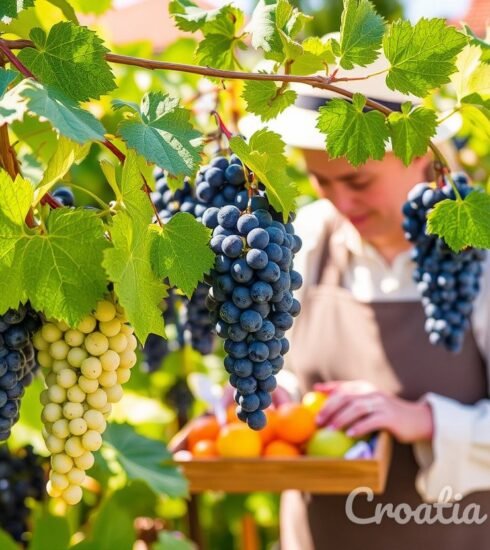Explore the Magic of Croatian Coastal Festivals: Hidden Harvests and Celebrations Await
Under the Croatian Sky: A Journey Through Hidden Harvests and Coastal Celebrations
The Croatian coastal festivals are a vibrant tapestry of culture, tradition, and community spirit, set against the backdrop of the stunning Adriatic Sea. These events not only celebrate the region’s rich agricultural heritage and diverse marine life but also invite locals and tourists alike to partake in the joyful gatherings that punctuate the summer months. With the warm Mediterranean sun kissing the shores, the festivals become a focal point for both cultural expression and economic opportunity.
The Essence of Croatian Coastal Festivals
Croatian coastal festivals are more than mere celebrations; they embody the spirit and resilience of the communities along the Dalmatian Coast. They showcase regional customs, artisanal craftsmanship, and traditional cuisines. Some of the most iconic events include:
- Feast of Saint James in Šibenik: This unique culinary event blends spirituality with gastronomy, highlighting the best of local produce and seafood.
- Dubrovnik Summer Festival: A cultural feast featuring music, theater, and dance performances set in the historical sites of Dubrovnik.
- Pula’s Film Festival: One of the oldest film festivals in Croatia, held in an ancient Roman amphitheater.
Each of these festivals weaves the stories of generations, tasting the flavors of the land, and celebrating the shared heritage that binds the people together. As visitors descend upon these gatherings, they encounter the heart of Croatian culture, enlivened by color, sound, and taste.
Harvest Festivals: Celebrating the Bounty
Croatia’s agricultural bounty is celebrated through myriad harvest festivals that highlight local produce and traditional farming practices. The Zadar Olive Oil Festival, for instance, draws enthusiasts from across the globe who eagerly sample the finest oils produced in the region. This event typically occurs in November, coinciding with the olive harvest season.

Statistics indicate that Croatia boasts over 100 million olive trees, with an average production of around 30,000 tons of olive oil per year. The festival showcases products ranging from quality extra virgin olive oil to artisanal breads, cheeses, and local wines.
Hidden Harvests: A Story of Sustainability
One cannot discuss Croatian coastal festivals without touching upon the sustainable practices that have evolved over time. Many events emphasize local sourcing and eco-friendly practices to celebrate the environment while supporting the local economy. For example, the Croatian Fishing Festival, held in various coastal towns, promotes sustainable fishing and marine conservation.
Local fishermen display their catches, while chefs conduct cooking demonstrations using the freshest seafood. This festival encourages responsible culinary practices, focusing not just on the catch of the day but on the importance of protecting marine ecosystems for future generations.
Cultural Traditions: The Heart of Coastal Celebrations
The Croatian coastal festivals are steeped in cultural traditions that date back centuries. Events like the Sinjska Alka reflect deep historical roots; this knightly tournament originated in the 18th century and pays homage to the victory over Ottoman forces. Participants, dressed in period costumes, display their skills in a spirited competition that draws thousands of spectators yearly.
Another integral part of the festival scene is the folk music and dance. Festivals are infused with traditional music, drawing on instruments such as the tamburitza and klapa singing, which consists of harmonized songs celebrating the sea, love, and community. Many festivals, such as the Croatian Heritage Festival, feature these expressions as an essential component of their programs.
Gastronomy: A Feast for the Senses
Food is at the heart of Croatian coastal festivals, with an emphasis on regional dishes, fresh ingredients, and traditional cooking methods. The coastal regions of Croatia are known for their distinct culinary influences, ranging from Mediterranean to Central European flavors.

- Peka: A traditional dish prepared with meat, vegetables, and herbs, cooked under a bell-like dome in hot coals.
- Pršut: Cured ham that is a staple in Dalmatian cuisine, often served with cheese and olives.
- Seafood Risotto: A creamy dish prepared with fresh shellfish from the Adriatic, flavored with local herbs and olive oil.
Many festivals feature food stalls where visitors can indulge in these regional specialties and participate in cooking workshops. These experiences connect people to the land, fostering an appreciation for Croatian gastronomy and its underlying traditions.
Community Engagement and Economic Impact
Croatian coastal festivals are a great way for communities to engage with each other and share their stories with visitors. They help to strengthen local bonds while boosting tourism. The economic impact of these festivals is significant; in recent years, it has been reported that festivals generate millions for local economies.
According to the Croatian National Tourist Board, tourism to Croatia increased by approximately 10% each year leading up to 2023, significantly due to the attractiveness of the coastal festivals that draw in visitors from all around the world. These events create numerous jobs, from vendors and service staff to performers and organizers.
International Recognition and Participation
Croatian coastal festivals have not only managed to retain their authenticity but have also gained international recognition. For instance, the Dubrovnik Summer Festival regularly attracts performers from prestigious international arts organizations and draws tourists from across Europe and beyond. This festival alone contributes extensively to Croatia’s visibility as a cultural hub in the region.
Furthermore, festivals like the Split Festival and the Festival of Mediterranean Film in Split have garnered invitees and participants from elite film and music industries, reinforcing the importance of cultural exchanges and collaborations.

Sustainable Tourism: The Future of Croatian Coastal Festivals
The emphasis on sustainability is becoming increasingly important for Croatian coastal festivals. Organizers strive to minimize their environmental footprints while educating attendees on the significance of responsible tourism practices. This includes:
- Utilizing eco-friendly materials for festival operations
- Promoting public transport or walking tours to reduce carbon footprints
- Encouraging the use of local products and zero waste initiatives
As a result, festivals create not only a memorable experience but also nurture a deeper connection to the environment and a call to action among attendees. Educational workshops on local flora and fauna are often incorporated into festival programming, fostering awareness on environmental conservation.
The Ambience and Atmosphere of Coastal Celebrations
The atmosphere during Croatian coastal festivals is alive with energy and vibrancy. Streets close to pedestrian traffic are filled with colorful stalls, live music, and joyous laughter, creating an inviting space for everyone. Vendors showcase handmade crafts, local delicacies, and traditional attire, transforming the coastal towns into vibrant cultural markets.
For both locals and tourists, festivals serve as gatherings where friendships are forged, stories are shared, and memories are created. As evening descends, the soft glow of lanterns and the sound of lively tunes fill the air. Fireworks often cap the evenings, leaving spectators in awe and forming an integral part of the celebratory experience.
Conclusion
As summer nights sparkle under the Croatian sky, the coastal festivals bring people together in a unique celebration of heritage, community, and enjoyment. These gatherings resonate with the past while providing economic benefits for the future. They heal communities, celebrate diversity, and underline the importance of cultural preservation against the backdrop of the stunning Adriatic landscape.






